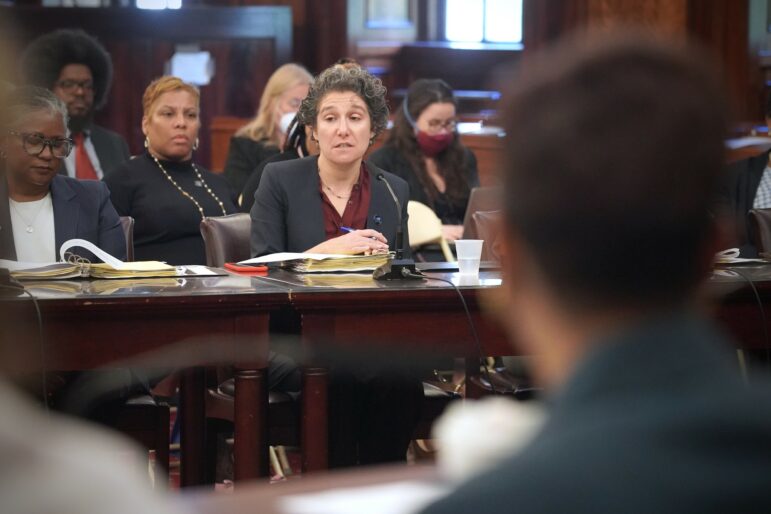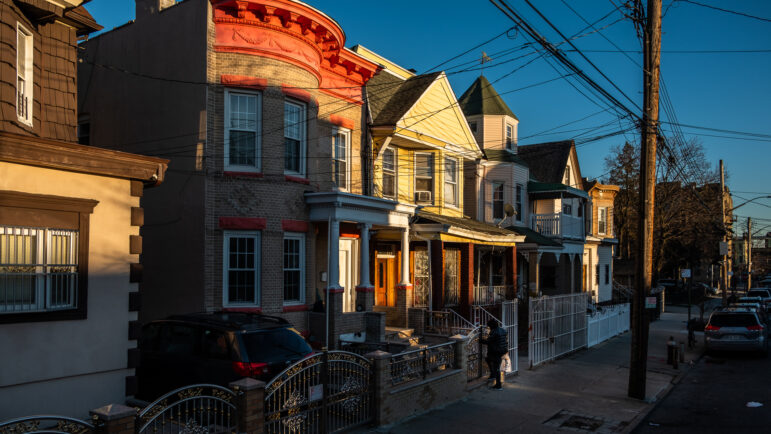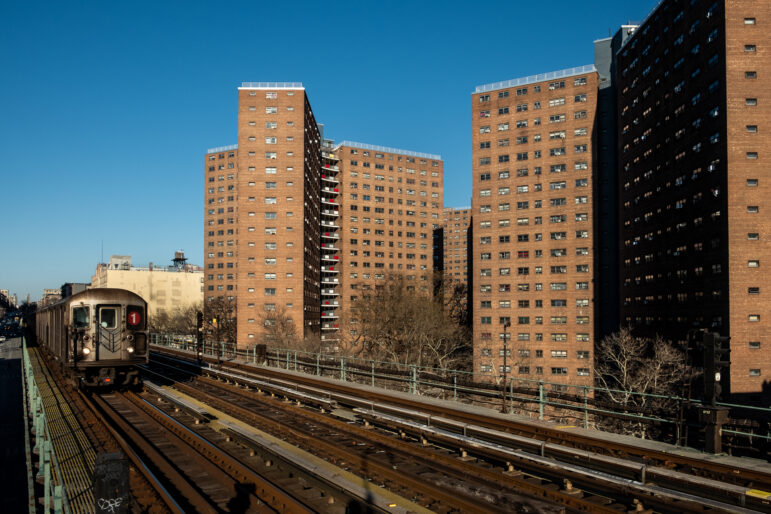At a Council hearing, officials said the city has recorded 318,000 “engagements” since February 2022 between street homeless residents and police or outreach workers, including instances where the same individual was contacted multiple times. Of those, 4,600 people have agreed to go into shelter; about 1,300 people remain in those placements.

Gerardo Romo / NYC Council Media Uni
Department of Social Services Commissioner Molly Park testifying before the Council’s General Welfare Committee on Monday.
On Monday, a week after 30-year-old Jordan Neely was choked to death on the subway, Department of Social Services Commissioner Molly Park described the difficulty of trying to help unhoused New Yorkers within the public transit system connect to shelter.
“Because we’re talking about individuals who frankly have been failed by every level of government and probably more than once, what we see is that it’s a real trust-building exercise that takes a very long time to do,” Park told members of the City Council, during a budget hearing on general welfare services.
The New York Times has reported that Neely was on the so-called “Top 50 List” of street homeless New Yorkers maintained by the city in conjunction with outreach teams. Park did not confirm this, but testified that, generally, the internal list helps the city track and coordinate care for “very, very high need individuals.”
A video posted to Facebook last week captured part of Neely’s fatal encounter with fellow subway rider Daniel Penny, who held him in a chokehold. According to one witness account, Neely had yelled that he did not have food or drink, and was fed up and didn’t mind going to jail, or dying. The city’s medical examiner ruled Neely’s death a homicide. The Manhattan DA’s office is investigating, and no arrests have been made.
On Monday, City Council members demanded to know how the city might have helped Neely more effectively prior to that fatal interaction. “I haven’t slept well in days, and I don’t know how anybody could, because this could have been avoided,” said General Welfare Committee Chair Diana Ayala.
The specifics of Neely’s case, including his past interactions with the legal and health care systems, are still coming into focus. But city stakeholders have long debated how best to help New Yorkers experiencing street homelessness, who say they are not always satisfied with city services, including often overcrowded group shelters.
Increasing the perception of safety on the subway while also connecting street homeless New Yorkers with shelter and services has been a main priority of the Mayor Eric Adams. Alongside Gov. Kathy Hochul, he launched multiple initiatives in early 2022, dispatching more police officers to the transit system as well as outreach workers.
Adams has also touted the benefits of specialized shelters known as Safe Haven and stabilization sites, which allow people to bypass the intake process required for larger congregate shelters, and can come with more privacy and fewer restrictions such as curfews. They are intended to appeal to the several thousand unhoused New Yorkers believed to be living on the streets. According to a Coalition for the Homeless review of city data, there are 3,100 Safe Haven and stabilization beds in New York City as of May 7, an increase of approximately 41 beds since the end of 2022.
A spokesperson for the Department of Social Services said 784 have opened since Adams took office. Efforts to open new sites have been met, in some cases, with local backlash: a group of Upper West Side residents, for instance, recently protested the opening of a Safe Haven on West 83rd Street; the city canceled plans to open another such facility in Chinatown last year following similar criticism.
Meanwhile, only a small share of police and outreach workers’ “engagements” with the unhoused since February 2022 have led to the types of outcomes the mayor and governor promised.
So far, Park said Monday, the city has recorded 318,000 such engagements—including instances where the same individual was contacted multiple times. Across those efforts “more than” 4,600 people have agreed to go into a shelter, Safe Haven or stabilization bed. About 1,300 people remain in those placements. “Absolutely there is still work to do but we are seeing real progress from that work,” Park testified.

Adi Talwar
An 80-bed SafeHaven shelter that opened last year for street homeless New Yorkers in The Bronx.In January 2022, Adams and Hochul announced that state-funded “Safe Option Support” teams would begin canvassing the trains with a focus on unhoused New Yorkers who have “a history of mental illness, substance use disorder, or other identified risk factors,” according to an announcement at the time.
The program launched last April, according to New York State Office of Mental Health spokesperson James Plastiras. In the first year, teams had 6,800 outreach encounters.
As of late April, 129 people had been placed in transitional or permanent housing, Plastiras said, while another 246 had been placed in “temporary and shelter” settings.
Following Monday’s hearing, service providers and advocates for the homeless agreed with Commissioner Park that it can be challenging to build relationships with, and assist, New Yorkers living on the street. But they also described measures that could help.
The mayor should walk back a budget proposal that would require nonprofit homeless services providers contracted by the city to reduce their spending by 2.5 percent, among other adjustments, said Catherine Trapani, executive director of Homeless Services United. Already, staff have noncompetitive wages and untenable caseloads, she said.
The reduction proposal is part of the mayor’s larger Program to Eliminate the Gap, or PEG, aimed at budget savings. Asked about it Monday, Commissioner Park said her agency was not taking it lightly. “We are not looking at layoffs and will certainly work with providers to figure out how to implement the PEG or adjust accordingly,” she said.
Terry Troia, president and chief executive officer of Project Hospitality on Staten Island, said her teams manage the borough’s street homeless outreach work in collaboration with the New York City Police Department, and need more staff.
“To establish a human relationship you have to show consistency, you have to be there. And when you’re running across the island… three, four, five places in the course of an hour, you don’t necessarily have the time to establish that relationship,” she said.
The city should also make more apartments available to street-homeless adults with minimal bureaucratic requirements or prerequisites, advocates said.
“We know that it takes building trust over time with individuals to help them make the decision to come inside,” said Shelly Nortz, deputy executive director for policy with Coalition for the Homeless. “I think where the city’s approach falls short is that there isn’t a great priority placed on moving people voluntarily into ‘housing-first’ circumstances, which skips over the—for many people—unnecessary trip to a shelter.”
Under the “Housing First” model Nortz described, people living on the street with mental illness get access to an apartment and can receive support services if they so choose, unlike other initiatives that require tenants to take part in programs or meet sobriety requirements.
A pioneer of the model, Sam Tsemberis, implemented it in New York City, though his organization Pathways to Housing filed for bankruptcy in 2015. One of his studies found that 88 percent of Pathways residents remained housed after five years, outpacing 47 percent in a control group that had to agree to treatment in order to receive housing.
Last fall, Mayor Adams touted a pilot program with Volunteers of America-Greater New York (VOA-GNY) aimed at moving 80 street-homeless New Yorkers into apartments with voluntary services. So far 66 people have moved in according to VOA-GNY, most of whom have physical or behavioral health needs. Placements occur following one or two weeks on average at a welcome center.
Spokesperson Claire McDonnell said in a statement Tuesday that the city has confirmed that this approach needs to be “part of its toolbox,” though the Department of Social Services did not have any details on future projects.
Emmy Tiderington, an associate professor at the School of Social Work at Rutgers University, urged the city to prioritize direct placements from street to apartment.
“There’s a lot of extra bureaucratic red tape that stands in the way of getting people into housing directly from the streets that needs to be cut,” she said. “Housing First worked here before—it can work here again.”









One thought on “In Wake of Subway Killing, City Officials Grilled On Touchpoints With Unhoused New Yorkers”
another proof that housing first does NOT work. Its treatment first with forced hospitalization for the non complaint mentally ill. We could have saved his life with a different approach! real care is not provided to the mentally ill because progressive delusions…